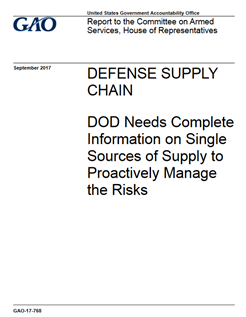Is Your Organization Prepared for a Supply Disruption?
Anne-Liese Heinichen
ERAI, Inc.
In March 2011, the Fukushima disaster resulted in global supply disruptions of silicon wafers, automotive parts and other electronic assemblies. In February 2015, a structural fire destroyed the
main plant at a GE Aviation facility located in Dowty in the UK. The facility was the sole manufacturer of propellers for Lockheed Martin’s C-130J aircraft.i While we have all heard the saying “don’t put all of your eggs in one basket”,
has your organization identified, documented, analyzed and prepared for a supply interruption, especially for parts from a single source of supply?
This question was also at the heart of a recently released Government Accountability Office (GAO) report entitled, “Defense Supply Chain – DOD Needs Complete Information on Single Sources of
Supply to Proactively Manage the Risks”. The GAO examined DOD’s report per Senate Report 114-49 which instructed DOD to provide a report which, “identifies major defense acquisition programs
with operational implications, a list of critical components of such major defense acquisition programs provided by single-source and/or single-provider suppliers, the severity of the operational
impact of the loss of such suppliers, and risk management actions with associated implementation plans and timelines the Department will take to prevent negative operational impact in the event of
such loss.”ii The GAO report found that the DOD’s October 2016 report addressed two of four elements required by the Senate, partially addressed one element and did not address a fourth element.
While much of the detail is specific to the Department of Defense, the report contains takeaways relevant to any organization:
-
An organization should recognize potential supply chain risks, including single source suppliers. These risks should be identified, monitored and assessed and supply chain risk management strategies should be employed.
-
Organizations should identify plans and timelines for risk mitigation actions.
-
Along with analyzing suppliers, your organization’s risk mitigation analysis should include what the GAO report called “organic facilities” or facilities/locations internal to your
organization such as maintenance, repair or storage facilities.
-
Organizations should employ the use of risk management or advisory boards to routinely review risks, mitigation plans and resources.
-
Ensure that identified risks and plans are shared throughout your organization. All relevant departments and facilities should be aware of product availability, obsolescence and other
factors as early as possible. Data and information-sharing systems play a large role in supply chain management.
-
Your organization should not rely solely or primarily on contractors to identify potential risks. Most organizations will not have a way to validate that contractors are sharing critical
information and may not themselves be fully aware of risks in sub-tiers of contracts.
- Implement proactive DMSMS management to mitigate risks, avoid costs and prevent schedule delays. It is estimated in the report that 98% of missile and munitions suppliers are single sources of supply where it may not be possible to find replacements or alternatives may be very costly. Ensure that your organization plans and budgets for obsolescence.
While DOD officials stated it would not be feasible to develop risk mitigation strategies for every supplier, they did acknowledge that doing so for critical suppliers would be appropriate.iii Each organization should ensure that effective processes are in place to account for supply chain disruptions. While commercial organizations may not be as seemingly adversely affected by a disruption such as in the mil-aero and defense communities, supply chain interruptions can substantively impact any organizations’ finances, damage a brand’s reputation and negatively affect business continuity.
The GAO report can be viewed online at:
https://www.gao.gov/products/GAO-17-768
_____________________________________________
i Norris, Guy. GE Dowty Assessing Fire Impact On C-130J, Q400 Programs. Aviation Week Network, 6 Feb. 2015, aviationweek.com/advanced-machines-aerospace-manufacturing/ge-dowty-assessing-fire-impact-c-130j-q400-programs.
ii United States, Congress, “S. Rept. 114-49 - NATIONAL DEFENSE AUTHORIZATION ACT FOR FISCAL YEAR 2016 REPORT.” S. Rept. 114-49 - NATIONAL DEFENSE AUTHORIZATION ACT FOR FISCAL YEAR 2016 REPORT, 19 May 2015. www.congress.gov/congressional-report/114th-congress/senate-report/49/1.
iii U.S. Government Accountability Office. “Defense Supply Chain: DOD Needs Complete Information on Single Sources of Supply to Proactively Manage the Risks.” U.S. Government Accountability Office (U.S. GAO), 28 Sept. 2017, www.gao.gov/products/GAO-17-768.
SEE MORE BLOG ENTRIES
|

|